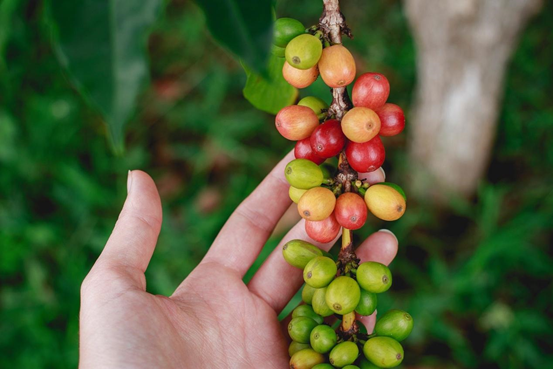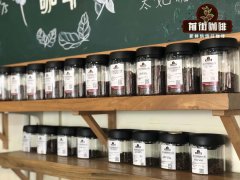Boutique coffee what are the producing areas of Colombian boutique coffee? What kind of coffee do you have in Colombia?

Professional coffee knowledge exchange more coffee bean consultation please follow the coffee workshop (Wechat official account cafe_style)
Boutique coffee is now the representative of the third wave of coffee. In the front street coffee bean list, let's talk about Colombian coffee beans today. Why so many people like its unique coffee flavor has a lot to do with its growing environment. The variety of coffee will also affect its flavor characteristics!
According to the Colombian Coffee Growers Association, the Colombian Coffee Association, the coffee industry provides 800000 direct jobs in the country and has a positive impact on 563000 households and the economy.
The country is in a good position for coffee production: it is close to the equator and its mountains can reach more than 2000 meters above sea level. For example, the Sierra Nevada de Santa Marta Mountains are one of the highest coastal mountains in the world.

North District
In northern Colombia, you will find coffee production divisions in Santander, North Santander, LaGuaxilla, Magdalena and Cesar Santander, Norte de Santander, La Guajira, Magdalena, and Cesar. According to Juan Carlos, 62500 producers grow coffee on 129500 hectares of land.
The region has only one dry season each year-December to March and one rainy season-April to November. Coffee blossoms in March, followed by the rainy season and harvested in October / November.
In addition, according to the Colombian National Coffee producers Association, the dimensions of coffee in the North District are more than 9 °, and coffee growing conditions are similar to those in Central America: low latitudes and high temperatures. On the other hand, in the Sierra Nevada de Santa Marta Mountains and the Santander and Norte de Santander areas, crops are more vulnerable to sunlight, so producers tend to grow in more shadows. According to the National Coffee producers Association of Colombia, coffee is produced in these areas with low acidity.
Central-northern and south-central regions
In the north-central and south-central regions of Colombia, there are producing areas of southern Antioquia, Boyaca, Caldas, Choco, Risalda, Jindio, the northern part of the Cauca Valley, Cundinamaka and northern Tolima.
Antioquia (Antioquia) is the second largest coffee producing area in Colombia and Tolima is the third largest. These two areas are very famous in the country. According to Juan Carlos, 263000 producers grow coffee on 492000 hectares of land in the area.
These regions have two dry seasons and two rainy seasons each year: the dry season from December to February and June to September, and the rainy season from March to May and September to November, resulting in two annual coffee harvesting seasons in the region.
In the north-central region, they have a major harvest season from October to December after the end of the second rainy season. However, after the end of the first rainy season, they will have a smaller harvest in May and June.
The harvest time in Central and South District is similar: may to June and October to November. However, it has no primary and secondary harvest seasons, and yields are the same in both periods.

Southern district
Southern Colombia is near the equator, and coffee grows in the higher mountains. This is a high-quality coffee growing area: coffee is famous for its high acidity and unique cup shape.
In the Southern District, 211000 producers grow coffee on 282000 hectares of land. This makes the average size of coffee farms in the region much smaller than in other parts of the country.
As in the North District, there is only one wet season and one dry season. The dry season lasts from June to September, then the coffee blossoms. The rainy season begins in October and may last until May, but the harvest season usually begins in April and lasts until June.
This is in stark contrast to the north of the country, where coffee is harvested in the autumn. As the harvest period is extended to December. In central Colombia, roasters can serve Colombian coffee to customers for most of the year.
Eastern district
Coffee is grown on a much smaller scale in eastern Colombia. It includes only areas such as Arauca,Casanare,Meta and Caquet á. 5500 producers grow coffee on 10500 hectares of land.
The region has suffered from armed conflicts in the past and support for coffee production has become a top priority. The National Coffee producers Association of Colombia is investing in helping the region grow varieties that better suit its environment, and they are also focused on helping farmers expand the size of their farms.
The climate of this area is similar to that of the north. However, there is more rainfall and humidity.

Coffee variety
In addition to the common coffee varieties in the Americas, such as Kaddura Caturra, Bourbon Bourbon, Tippika Typica and Parkmara, Colombia also has its own three disease-resistant varieties, namely Castillo Castillo and Tabi Tabi Colombian Colombia with the same name as the country. Of course, there are also some rare and valuable varieties such as Rosa Gesha, small-grained Mocha Mocca, Rume Sudan Romer Sultan, Eugenioides Eugene Odes, Laurina pointed Bourbon, Maraguesa Mara Rosa (a natural hybrid between Marago Rippi and Rosa).
For more boutique coffee beans, please add private Qianjie coffee on Wechat. WeChat account: kaixinguoguo0925
Important Notice :
前街咖啡 FrontStreet Coffee has moved to new addredd:
FrontStreet Coffee Address: 315,Donghua East Road,GuangZhou
Tel:020 38364473
- Prev

Boutique coffee Columbia boutique coffee what is the price of San Jose coffee beans?
Professional coffee knowledge exchange more coffee bean consultation Please pay attention to coffee workshop (Wechat official account cafe_style) mentioned individual coffee, many people will like to drink Colombian coffee, its aroma is rich and thick, it tastes neither as strong as Brazilian coffee, nor like African coffee with obvious acidity, but with clear high quality acidity, high balance, sometimes strong
- Next

Is the balance of Blue Mountain Coffee good? What is the balance of coffee? Coffee with a balance of sweet and sour
The word balance gives people a very illusory feeling, unlike sweetness, acidity, taste, cleanliness, these very intuitive feelings. It is more like a co-ordinating role. What is the degree of balance? Many people will think that the so-called balance is not sour, bitter, sweet mutual checks and balances to achieve a balanced cup of coffee. In reality, many people have tasted a cup.
Related
- Beginners will see the "Coffee pull flower" guide!
- What is the difference between ice blog purified milk and ordinary milk coffee?
- Why is the Philippines the largest producer of crops in Liberia?
- For coffee extraction, should the fine powder be retained?
- How does extracted espresso fill pressed powder? How much strength does it take to press the powder?
- How to make jasmine cold extract coffee? Is the jasmine + latte good?
- Will this little toy really make the coffee taste better? How does Lily Drip affect coffee extraction?
- Will the action of slapping the filter cup also affect coffee extraction?
- What's the difference between powder-to-water ratio and powder-to-liquid ratio?
- What is the Ethiopian local species? What does it have to do with Heirloom native species?

